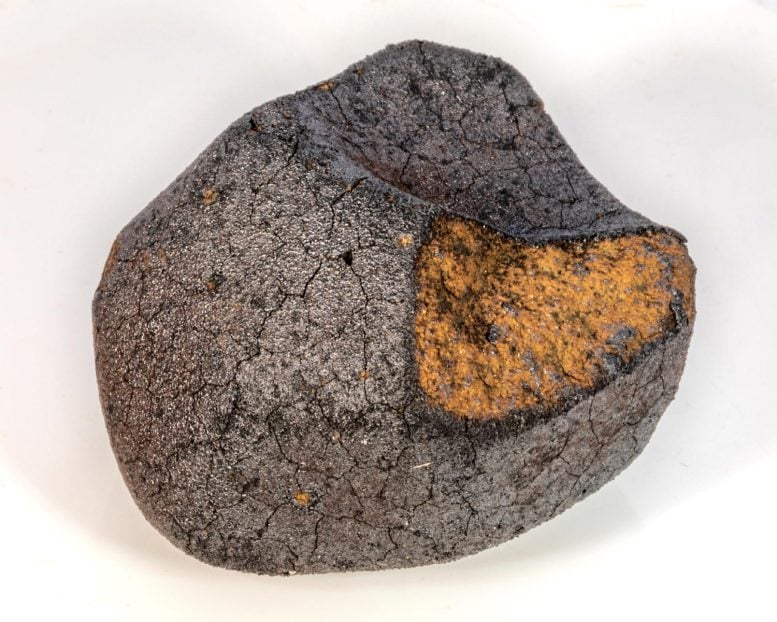
The Chilling Secret Behind Earth’s Water
-
by Anoop Singh
- 10

The meteorite known as “Flensburg” fell onto the Earth’s surface on 12 September 2019. It is a rare carbonaceous chondrite with a diameter of between 3.5 and 3.7 centimeters weighing just under 25 grams. It only contains minerals emerging in the presence of water. The analysis of the meteorite – its parent body formed approx. 2.7 million years after the emergence of the solar system – has played a major role in explaining how such small bodies could form not only at hot temperatures in the young solar system, but also later, at lower temperatures, so that their water was preserved. Credit: © Carsten Jonas, CC BY-SA 4.0
A study has shown that water-rich planetesimals formed in the cold outer reaches of the early solar system were instrumental in supplying Earth with water, essential for its habitability.
Age data for certain classes of meteorites have made it possible to gain new findings on the origin of small water-rich astronomical bodies in the early solar system. These so-called planetesimals continually supplied building materials for planets – also for the Earth, whose original material contained little water.
The Earth received its actual water through planetesimals, which emerged at low temperatures in the outer solar system. Ice was available there as solid-state water – unlike with small bodies that had evolved earlier and were too hot for that, being closer to the sun.
Computational models carried out by an international research team, with participation by earth scientists from Heidelberg University, have shown this on the basis of the age data, from which they were also able to read the parent bodies’ thermal evolution.
Formation of the Solar System and Earth’s Development
The planets of our solar system formed together with their mother star, and the Earth did likewise, emerging about 4.5 billion years ago around the sun. This happened in the habitable zone, which meant that water was able to exist in liquid form on its surface. The Earth, like other planets, also grew out of planetesimals. They emerge when large quantities of dust particles accrete in high pressure zones several thousand kilometers in diameter, and collapse under their own gravity.
“These small bodies did not just supply the building materials for the planets,” explains Prof. Dr Mario Trieloff, who directs the Klaus Tschira Laboratory for Cosmochemistry at Heidelberg University’s Institute of Earth Sciences. They are also the source of the Earth’s water, the scientist adds.
Evolution and Characteristics of Early Planetesimals
The circumstances under which the planetesimals actually originated in the early solar system, and whether this was also possible for considerable periods of time, have so far not been finally clarified. Important information in this regard is supplied by the age data of certain classes of meteorites, which at some stage separated from small planets.
In cooperation with colleagues from Berlin, Bayreuth, and Zurich (Switzerland), the Heidelberg scientists have derived the thermal evolution and point of origin of the mother bodies from this data. They show that some of the planetesimals formed very quickly, meaning within less than two million years. In that case, they heated up so strongly that they melted and lost all volatile elements, including their water.
Role of Planetesimals in Earth’s Hydration and Potential Extraterrestrial Life
Other planetesimals, according to the findings of the current study, arose later at lower temperatures in the outer solar system; they were partly able to conserve their water bound up in crystals. The fact that these small bodies were also able to continually form at later stages of the solar system is, according to the scientists, due to various delaying effects counteracting the mechanisms of rapid origin, for example, collisions between dust agglomerates − the building materials of planetesimals − which prevented the rapid growth of small planets.
“The Earth accreted such small water-rich planets or their fragments in the form of asteroids or meteorites during its growth process and that is the only reason why it did not become a bone-dry planet, hostile to life,” says Dr Wladimir Neumann, first author of the study, which is based on research carried out at Heidelberg University, the Institute of Planetary Research at the German Aerospace Center and the Institute of Geodesy at TU Berlin.
Since the origin of planetesimals in extrasolar planetary systems is based on the same physical laws as in our solar system, the scientists assume that there could also be planets similar to the Earth in other regions of space. If they have received water from small bodies in the course of their evolutionary history they could meet the preconditions for the origin of life, according to Prof. Trieloff.
The research findings were published in the journal Scientific Reports.
Reference: “Recurrent planetesimal formation in an outer part of the early solar system” by Wladimir Neumann, Ning Ma, Audrey Bouvier and Mario Trieloff, 31 June 2024, Scientific Reports.
DOI: 10.1038/s41598-024-63768-4
Participating in the investigations were scientists from TU Berlin, the German Aerospace Center, ETH Zurich (Switzerland) and the University of Bayreuth. Funding for the research studies came from the German Research Foundation, the Klaus Tschira Foundation and the International Space Science Institute in Bern (Switzerland) and Beijing (China).
The meteorite known as “Flensburg” fell onto the Earth’s surface on 12 September 2019. It is a rare carbonaceous chondrite with a diameter of between 3.5 and 3.7 centimeters weighing just under 25 grams. It only contains minerals emerging in the presence of water. The analysis of the meteorite – its parent body formed approx.…
The meteorite known as “Flensburg” fell onto the Earth’s surface on 12 September 2019. It is a rare carbonaceous chondrite with a diameter of between 3.5 and 3.7 centimeters weighing just under 25 grams. It only contains minerals emerging in the presence of water. The analysis of the meteorite – its parent body formed approx.…
